
During Yellowstone’s early days, people still hunted buffalo in the park for trophies. That changed radically in 1894 when Army soldiers in Yellowstone Park captured bison poacher Edgar Howell and posed with eight of the confiscated bison heads. Only 23 original bison remained in Yellowstone in 1916 when park managers began some of the nation’s first efforts to save the endangered species.
Brucelosis has a devastating effect on cattle, in that infected cows abort their first calf, and sometimes the infection stays in the system for years. The disease also infects Bison and elk.
European cattle initially brought the bacteria Brucella abortus to the new world. The disease especially spread through dairy cattle, but wild bison and elk in the Greater Yellowstone Area became infected with the disease before the 1930s.
The brucellosis vaccines available today are considered only 65% effective for cattle and even less so for bison and elk.
It’s complicated. And because they are live vaccines, they can bring the infection itself.
Heifer calves need to be vaccinated before the age of 12 months. Otherwise, if any are pregnant at the time of vaccination, they may abort and potentially spread the disease to herd mates or even people getting in contact with the aborted fetus and placenta.
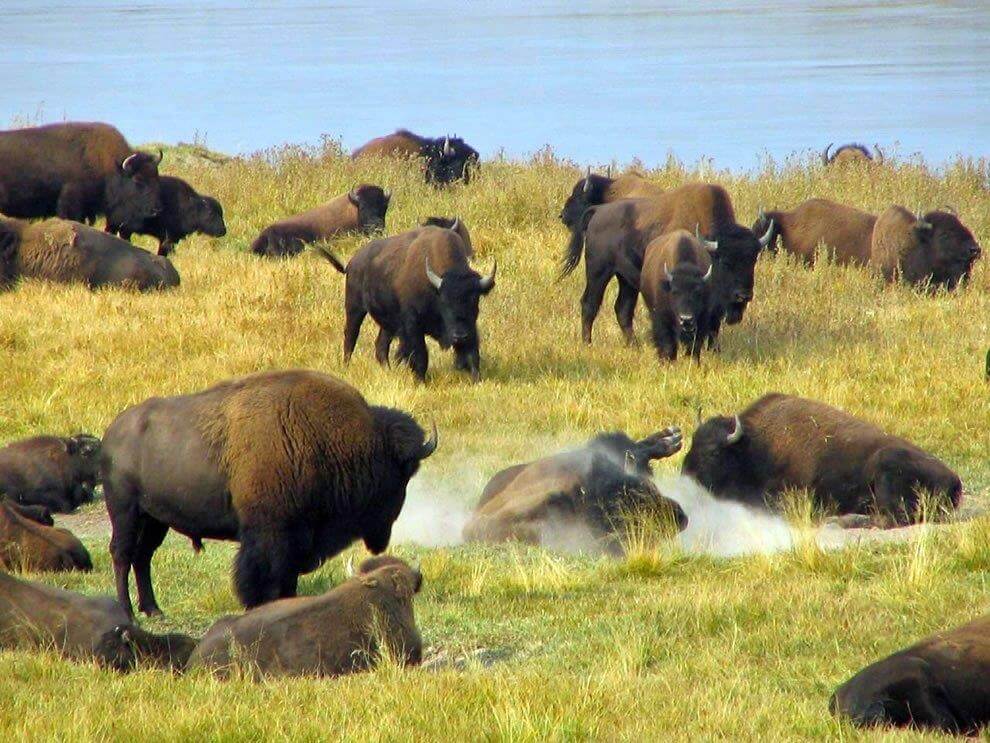
Yellowstone Park herd looks on as one buffalo enjoys a dust bath undisturbed. Others await their turn.
There is hope of better vaccines to come, but it may be quite a long time.
New vaccines are under development at several University research labs, according to The U.S. Department of Agriculture’s (USDA) Animal and Plant Health Inspection Service (APHIS), which is in charge. Their website on brucellosis states:
“Unfortunately, we lack not only a proper treatment but also a reliable diagnosis.
“Adequate and timely diagnosis of brucellosis is necessary to control and treat the disease in the best way. Different serological and molecular methods are used for the screening of the disease. However, each test has some drawbacks in one way or another.
“Vaccination is an effective strategy to prevent the spread of brucellosis and is in practice worldwide.
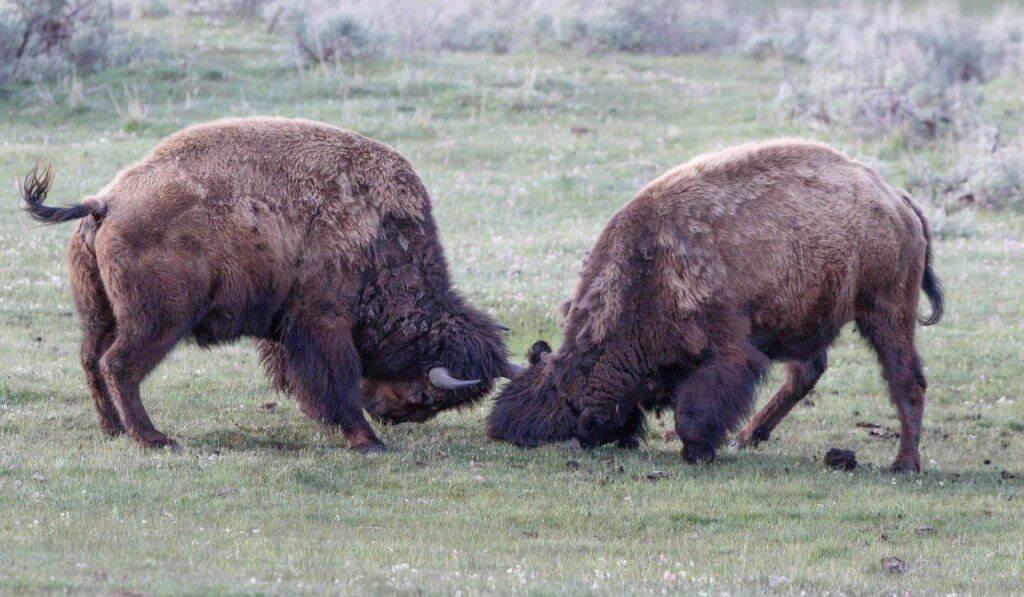
Bulls spar off during rutting season. But most confrontations are brief and end in quick retreat for the smaller, younger bull. NPS
“However, there is demand for the development of new vaccines that are safer and more effective.
“With rising interest of the scientific community in brucellosis, a significant improvement in diagnosis and treatment is expected. We are also in need of a broad-spectrum vaccine against Brucella for complete eradication of the disease worldwide.
“APHIS continues to support brucellosis research at universities and is also working with USDA’s Agricultural Research Service to further study RB51 vaccine, and to develop alternative brucellosis vaccines that would be more effective in wild bison and elk herds.
“Current vaccines are about 65 percent effective. It is unlikely that new vaccines would protect 100 percent of vaccinated animals. However, new vaccines may provide additional protection for the animals and help reduce the incidence of the disease within the herds.
“APHIS is also involved in studying the brucellosis disease agent—how it is transmitted and shed by infected animals into the environment.“
“It took a huge effort in eradicating this disease from cattle in the United States. But as of March 1, 2002, nearly all states have achieved brucellosis-free status with no known infection.
“The only known focus of Brucella abortus infection left in the nation is in bison and elk in the Greater Yellowstone Area. However, this has been a tremendous problem for ranchers in nearby areas of Wyoming, Montana and Idaho.”
Until all brucellosis is wiped out—there will continue to be great problems and controversy in the Yellowstone Park area.
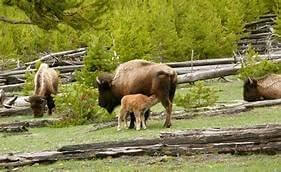
Cow with young calf grazing in downed timber clearing in Yellowstone Park.
How does Brucellosis Infect?
Brucellosis is primarily spread within and among bison, elk and cattle during calving season when susceptible animals ingest Brucella bacteria from birthing materials (amniotic fluids, fetus, placenta) or the newborn calf.
Mother elk clean up most of it when they calve outside the park, and scavengers consume most of what remains. But perhaps not all. A secondary mode of infection is through the milk when actively infected females nurse their calves.
Females are often infected with Brucella bacteria at a young age, but do not shed the bacteria until they become reproductively active at around age 3, when conditions become favorable for bacteria to multiply and spread in the reproductive tract during the last months of pregnancy.
At that time, the bacteria can rapidly increase in cells of the placenta and induce abortions, still births, and premature live births in some animals.
Some females appear to recover and clear the bacteria from their bodies after this initial pregnancy, but others retain the infection and can become infectious during additional pregnancies.
Infected male bison shed Brucella bacteria in semen, but do not infect females during breeding because of the fluids in the vagina that are fatal to the bacteria.
In addition, bison and elk are more vulnerable to infection when their immune defenses are weakened, as during winter starvation. Risk comes primarily in February through June when most brucellosis-induced abortions occur.
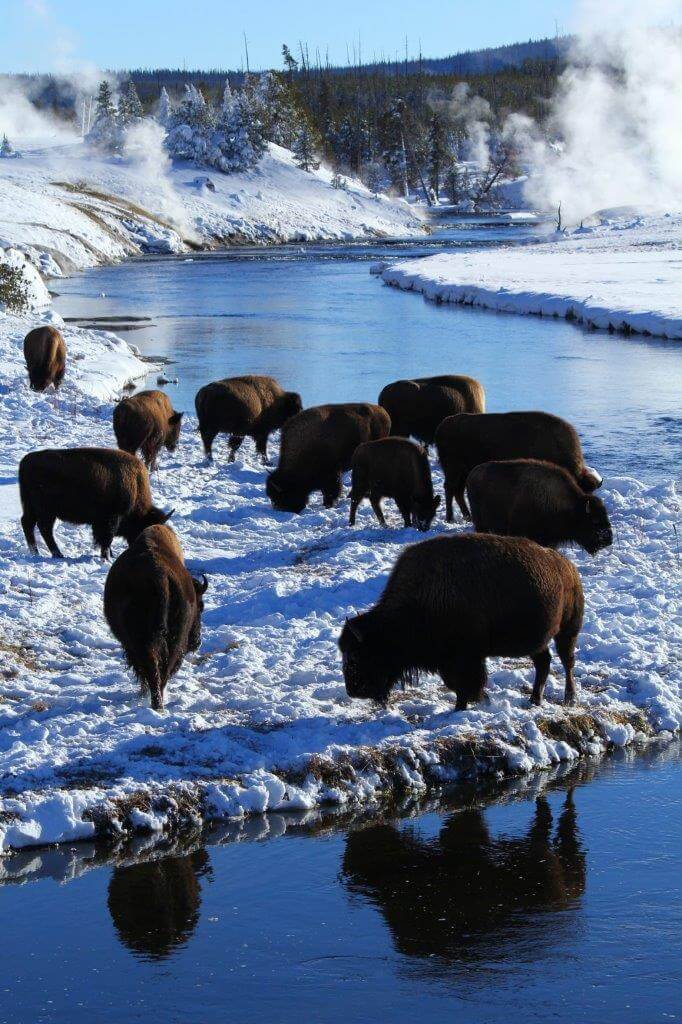
In background steam rises from hot spots. Warm geyser keeps open water for drinking in the creek, no matter how frigid the day.
Brucellosis in Humans
In humans, brucellosis–also known as Bang’s disease—is called undulant fever, human brucellosis or Malta fever. It is world-wide in distribution.
According to the Journal of the American Medical Association infections may spread to humans through cuts or bruised skin or infected milk. It evidently does not affect the meat, which may be eaten.
People with undulant fever may suffer weakness, headache, painful joints, loss of weight and appetite, alternating chills and fever, profuse sweating, sleeplessness and numbness of arms and legs. It is seldom fatal, but can become chronic or long-lasting and weaken resistance to other diseases.
More than $3.5 billion has been spent since 1934 to eradicate brucellosis from cattle in the United States.
My husband Bert was part of this program, spending his first summer after college graduation in 1953—before continuing his Veterinary Medicine studies—testing North Dakota cattle herds for brucellosis.
During that time he was diagnosed with undulant fever. But although it stayed in his system long-term from that experience, he was generally able to ignore his symptoms.
Bert was most saddened though, by infected cattle herds that had to be condemned. It was the only way of eradicating the disease.

Shedding winter hair in rag-tag patches, one at a time. For a hairy bull it can take a month or two—or all summer.
Low Point in Buffalo Numbers
The lowest point of buffalo numbers in Yellowstone Park was probably around the turn of the century.
In 1916 the original bison were counted at only 23 head. That’s when park managers began their first efforts to save bison as an endangered species.
Many people today, researchers as well as others, seem to believe these were Mountain or Woods buffalo and they are calling today’s Yellowstone Park buffalo a hybrid of the two subspecies—Wood buffalo and Plains buffalo.
I very much doubt whether that can be true.
Apparently, those bison were counted in the summertime, and likely included a few calves and young animals. So they’d have had relatively few fertile cows and I doubt that they would have birthed many calves.
Also the Wood bison probably would not interbreed widely, since they tend to be shy and scattered.
In fact, those early herds as well as those introduced could have been simply the wilder Plains buffalo that had found remote mountain canyons to hide from relentless hide hunters—as surviving bison did throughout the west.
Is it really logical to assume that the two—Wood and Plains bison—interbred widely to form a new hybrid subspecies?
Possible, of course, but probably wishful thinking on someone’s part.

Good swimmers, sometimes YP bison get caught in the ice in springtime.
Soon Excess Numbers Needed Culling
Since 1932 the buffalo in Yellowstone Park have been periodically culled to keep the totals down to a reasonable number for good grazing and to balance the needs of other grazing wildlife.
Eventually the YP bison numbers were targeted at around 3,000 in the Park, although they often reached nearly 6,000 before culling.
After 1960 the culling operation became better organized. As many bison as possible were herded by two coordinating helicopters into one of two traps—the Crystal trap at Lamar in the northeast quarter and Nez Perce trap on the Firehole River nearly 35 miles farther southwest.
By the winters of 1964-65 and 1965-66 squeeze chutes handled most of these trapped bison and they were either sorted for release or trucked to a local slaughterhouse, according to Margaret Mary Meagher, Research Biologist of the National Park Service, author of “The Bison of Yellowstone National Park,” 1973.
Most were aged by Department of Agriculture veterinarians and weighed. Also 47% of the animals removed from the park were examined for pregnancy, abnormalities, and evidence of injury or disease other than brucellosis.
Selected for butchering were bison with brucellosis suspected as well as those with abnormalities and injuries. The meat from healthy animals was packaged, frozen and delivered to Native tribes.
However, reproductive tracts were not examined, because about half of removed bison were brucellosis suspects.
Department of Agriculture veterinarians advised staff against such exams of reproductive organs, where the Brucella organism localizes, to avoid contamination of slaughterhouse premises and exposure of personnel to the disease.
All animals were permanently metal ear tagged and marked with temporary backtags, which were visible even from an airplane.
Fertility control along with culling is being considered in limiting the bison population in Yellowstone. For example, one type of contraceptive vaccine being investigated for possible use in bison would form antibodies that block sperm from fertilizing eggs. Another prevents follicle growth and ovulation.
However, available methods fail to be affordable, very effective, reversible or easily delivered to wild bison and elk that are spread across the vast landscape that is Yellowstone Park.
Further, they would likely have unintended consequences—such as altering the behavior and physiology of wild bison by changing the herd’s age structure.
USDA is charged with eradicating brucellosis from the United States and also remains committed to maintaining a viable and free-roaming bison herd in Yellowstone National Park.
(For more information on attempts to solve this problem, see “Part 1—InterTribal Buffalo Council Restores Herds—and More,” and “Part 2—ITBC, 30 years—Yellowstone Bison Dilemma,” blogs by Francie M Berg, Dec 29, 2020 and Jan 12, 2021. One solution has been quarantining young Yellowstone Park bison that test negative for brucellosis, raising them fenced away from the herds for as many as 5 to 8 years, while annually testing and finally allowing them to join specific tribal herds under strong fences.)
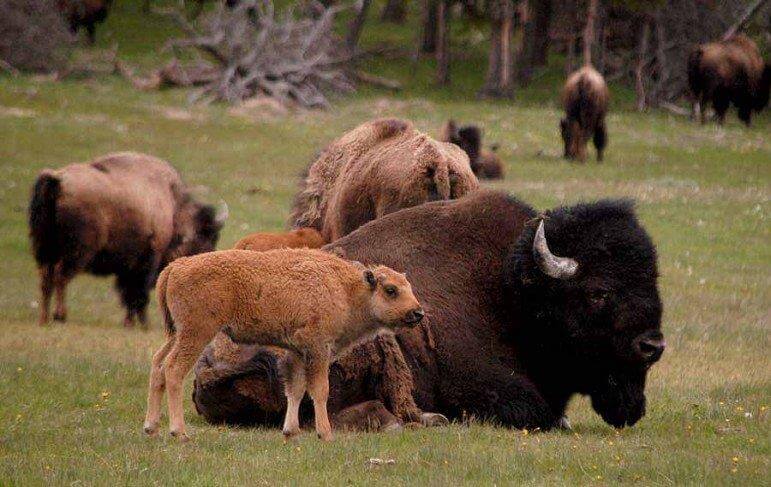
A New Plan gets Underway
A long-term plan for moving ahead with these issues is being made. The new plan includes both ranching and tribal interests at the table.
Of course, it’s difficult. The time for inviting public comments ended the last of February 2022.
Indian tribes today are insisting on what they see as their rights. Mostly they want to stop the butchering of excess bison in Yellowstone Park. They also do not want the bison altered in any way.
Instead, they’d like to bring the excess animals into their own buffalo herds. Many revere the Yellowstone Buffalo for their history as the last wild bison in America.
Indeed some tribes can point to treaties in which they were promised they could hunt and be in control of these areas “as long as the sun shines” or basically forever.
Certain tribes are allowed to hunt bison as they come out of the Park. Many environmentalists and others agree that is only right.
Cattle ranchers in the area are appalled by the idea of free-ranging elk and bison—which are both frankly considered to be about 50% infected with brucellosis—grazing the same ranges outside the Park in the Yellowstone area, even if at different seasons.
So far they’ve been able to get the Montana Legislature to agree with their rule: “To not allow live bison to leave the Park. Period.”
Thus no cattle have been reported as brucellosis infected by bison to date. No cattle are inside the Park and no bison are outside.
The wild elk are a different story. They are free to wander where they wish. Many elk leave the Park for better foraging when the snow gets too deep in the higher mountains.
There have been reports of vaccinated cattle infected with brucellosis from elk.
The experts point to the winter of 1996-97 when, with the Yellowstone Park herd at record levels, the limited forage in the Park was covered with record levels of ice and snow. Large numbers of bison moved outside the park looking for food.
Exiting the Park that winter were 1,079 bison that were then shot or sent to slaughter. An additional 1,300 or more bison starved to death inside the park because they could not paw their way through the ice.
There is a belief that bison need an area at the lower altitude outside the Park for grazing in tough winters.
“Research efforts are also underway to develop a safe and effective vaccine delivery system so that bison can be vaccinated remotely, as opposed to only hand injection,” according to the APHIS plan.
“In addition, APHIS has a veterinarian with wildlife management training and experience stationed in Montana, to function as a liaison among involved government agencies.
“APHIS is confident that, as more activity is generated on this issue, this liaison position will become increasingly important in ensuring that all involved parties are informed and that APHIS’ involvement is coordinated.
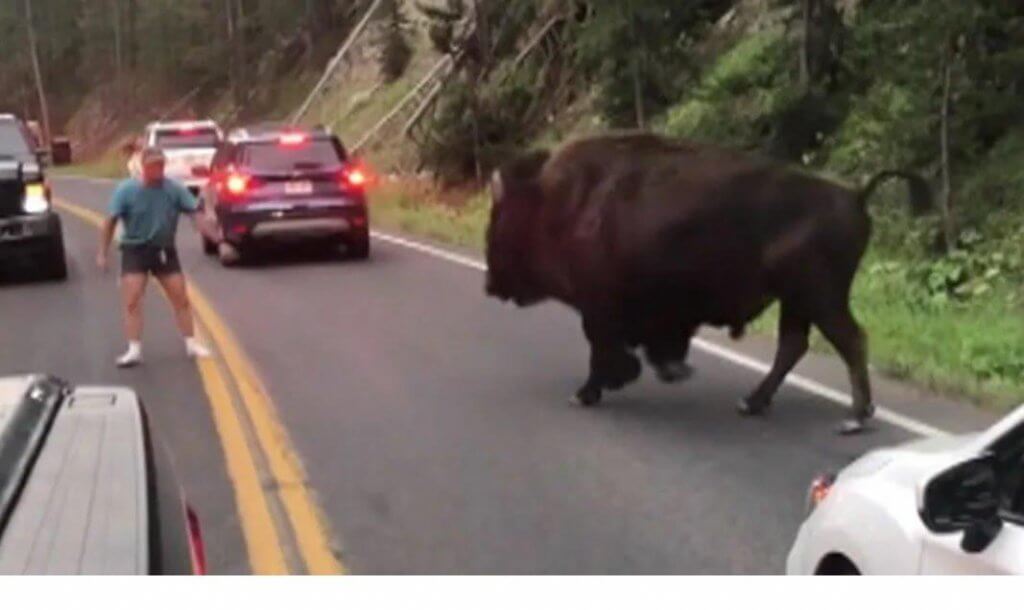
A tourist taunts an unpredictable bull who can turn on a dime and run faster and longer than he can—although he probably doesn’t know that.
Can Brucellosis be eradicated from Yellowstone wildlife?
“Yes,” replies APHIS to its own question.
“APHIS officials are confident, based on experience in other public and private bison and elk herds and on other successful disease eradication programs, that use of a combination of disease-eradication and herd-management measures will lead to the successful elimination of brucellosis from bison and elk in the Yellowstone ecosystem.”
Wow! They sound pretty confident—but it’s clear this will not happen soon.
“Currently the best alternative for wildlife and livestock managers is to suppress the probability of Brucella abortus transmission by maintaining separation between bison, elk, and cattle during the period from February through June when calves are born and bedgrounds are being infected,” say USDA officials.
The new plan for how this might be accomplished will soon be announced—and you can be sure we will report it to you in our blog.
_____________________________________________________________
NEXT: Saving Orphan Buffalo Calves
_____________________________________________________________

Francie M Berg
Author of the Buffalo Tales &Trails blog



Thanks Francie. I enjoy reading your blog as I always learn something new. Here’s hoping that they come up with a more effective vaccine!
Carol
Hi Carol
Yes, it would be a blessing if researchers could stop brucellosis infections worldwide–in humans, livestock and wildlife! Thank you for writing.
Francie